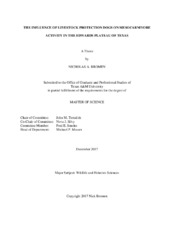| dc.description.abstract | The use of livestock protection dogs (LPDs; Canis lupus familiaris) to deter predators from preying upon sheep and goat herds continues to increase across the United States. Most research regarding the efficacy of LPDs has been based on queries of rancher satisfaction with their performance, yet little is known regarding whether LPDs actually displace the predators they are commissioned to protect livestock from. Here, I examined whether the presence of LPDs amid livestock resulted in fewer observable detections of carnivores in pastures they occupied throughout 1 year on a ranch in central Texas. To detect and quantify the presence of carnivores across the ranch, a remote camera grid and scat transects were simultaneously surveyed to compare results produced between each method. Four LPDs were fitted with GPS collars to collect their positions and evaluate their occupancy across the ranch over time. These GPS collars also collected proximity data on a random sample of UHF collared sheep (n = 40) and goats (n = 20) to gauge the frequency to which the LPDs were near livestock.
Remote cameras and scat surveys detected the same mesocarnivore species (badger [Taxidea taxus], bobcat [Lynx rufus], coyote [Canis latrans], gray fox [Urocyon cinereoargenteus], raccoon [Procyon lotor], ringtail [Bassariscus astutus], and skunk species), though in different proportions. No large carnivores were detected and no significant difference was observed between the results of the 2 methods across sampling units (U=164.5; P=0.37, Mann-Whitney U-test) or over time (U=68; P=0.84, Mann-Whitney U-test). Both methods detected a rise in mesocarnivore activity during the fall and early winter. LPDs were within 100– 300 m of livestock for 99–100% of days evaluated. Detections of known depredators to livestock (bobcat and coyote) were 31.2% lower in pastures occupied by LPDs amid livestock (χ² =5.91, df=1, P<0.05 and χ² =0.45, df=1, P>0.05, respectively) and lower for raccoon (χ² =6.84, df=1, P <0.01 while detections of less ominous gray foxes were significantly higher in LPD occupied pastures (χ²=13.21, df=1, P<0.01). These results provide support for LPDs as a predator management tool which can displace known depredators of livestock from the pastures and herds they protect. | en |


